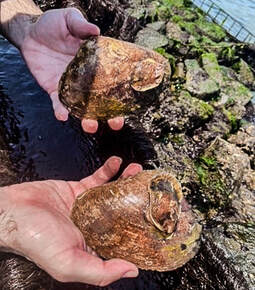|
While the heavy lifting may be done at the Littoral Society's project in Forked River Beach, NJ, work at the site will continue for the foreseeable future. In addition to monitoring and maintenance of the living shoreline project, which is designed to protect homes and habitat along an eroding section of Barnegat Bay's shoreline while also reducing the amount of sediment getting into the water, Littoral Society staff will continue meeting with and speaking to residents and officials from the surrounding community. Reef building was completed on Oct. 16-17, with installation of the final sections by our contractor Albert Marine Construction. The protective reef now runs just offshore from near the mouth of Forked River in the north, to a lagoon located at the southern end of Beach Boulevard. Those final reef sections mark the first use of recycled shells from the Littoral Society's "Shuck It, Don't Chuck It!" program in a major restoration project. The reef has also been seeded with 32 million live oyster, as part of the Littoral Society's effort to help bring those bivalves to New Jersey's coastal waters. The fruits of that effort are already evident: during this year's monitoring at the site, live oysters were found living on the reef.  Oysters growing on clam shell at Forked River Reef. Oysters growing on clam shell at Forked River Reef. "In addition to seeing our spat (oyster larvae attached to shells) taking hold, we were very pleasantly surprised to find live naturally occurring oysters growing on the offshore reefs, which indicates the potential for natural oyster beds to be nearby," said Julie Schumacher, Habitat Restoration Coordinator for the Littoral Society. Historically, Barnegat Bay had over 12,000 acres of eastern oyster beds. Today, nearly the entire natural oyster population is gone. With their elimination, Barnegat Bay not only lost the oysters themselves, but the things they did for the bay such as reducing the force of waves on shorelines, filtering water, reducing turbidity, and providing living space for other marine life. The disappearance of oysters – and the reefs they build – hit home in the Forked River Beach community, as erosion reached a point that the bay was flowing into some homes during high tides. The site has lost more than 150 feet of shoreline since 1995, with erosion accelerating after Superstorm Sandy in 2012. Increased sediment in water from shoreline erosion has also impacted the water quality of Barnegat Bay. To stabilize the shoreline and reduce the amount of sediment in the water, the Littoral Society designed a project that would include 168 reef segments. Each segment was hand-built by volunteers to approximately 12 feet long by 5 feet wide and 4 feet high. The reef segments consist of HESCO units, which are portable protective barriers often used by the US military. The four-foot-by-three-foot steel wire crates can be filled with various kinds of material - from dirt or sand to rock and shell. For this project, each HESCO unit/reef segment is three connected galvanized steel baskets surrounded by eight outer pockets filled with shell. The interior baskets contain rock to help keep them in place. On Oct. 18, the Society hosted a group of students from Kean University for a field day at the site. Students assisted staff in building lids for the HESCO units, gathering loose shell dispersed along the shoreline and intertidal zone, and conducting biological assessments of monitoring cages for oysters and other aquatic species. Students also collected water samples to test levels of dissolved oxygen percentage, turbidity, and other parameters. Moving forward, Society staff will continue monitoring the site, looking for signs of biodiversity, oyster growth and frequency distribution, water quality, and structural integrity. In addition to ongoing monitoring, the team will continue to promote the Community Watch Volunteer Program and manage surveillance cameras that will be used to record wrongful activities on and around the reef, such as poaching. The project began in 2021 with the help of partners and funders including: the New Jersey Department of Environmental Protection (NJDEP), New Jersey Corporate Wetlands Restoration Partnership, Lacey Township, Bayside Beach Club, Stockton University, Albert Marine Construction, the US Fish & Wildlife Service, ReClam the Bay, Parsons Seafood, and Wildlife Restoration Partnerships. Comments are closed.
|
Archives
July 2024
Categories
All
|


